Shade-tolerant vegetables such as spinach, kale, and Swiss chard thrive in forest gardens by efficiently utilizing low-light conditions under tree canopies. These leafy greens contribute to biodiversity while providing nutritious, continuous harvests throughout the growing season. Selecting appropriate shade-resistant crops enhances soil health and maximizes space in shaded garden areas.
Introduction to Shade-Tolerant Vegetables in Forest Gardens
Shade-tolerant vegetables thrive in the low-light conditions commonly found beneath tree canopies in forest gardens, making them essential for maximizing garden productivity. Varieties such as leafy greens, root vegetables, and herbs exhibit adaptability to dappled sunlight and partial shade, promoting biodiversity and soil health. Integrating these crops supports sustainable agroforestry practices by optimizing vertical space and enhancing ecosystem resilience.
Benefits of Growing Vegetables in Shaded Forest Garden Environments
Growing shade-tolerant vegetables in a forest garden maximizes space efficiency by utilizing under-canopy areas that receive filtered sunlight. These vegetables often require less water and are less prone to heat stress, promoting sustainable cultivation in warmer climates. Cultivating shade-loving crops like leafy greens and root vegetables enhances biodiversity and supports soil health through reduced erosion and improved nutrient cycling.
Top Shade-Tolerant Vegetable Varieties for Forest Gardens
Top shade-tolerant vegetable varieties ideal for forest gardens include leafy greens like spinach, kale, and arugula, which thrive under partial canopy cover. Root vegetables such as beets, carrots, and radishes also perform well in low-light conditions typical of forested areas. Herbs like mint and chives further enhance forest garden biodiversity by flourishing in shaded understories while providing culinary and medicinal benefits.
Criteria for Selecting Shade-Loving Vegetables
Shade-tolerant vegetables thrive in low-light conditions, making them ideal for forest garden understories with dense canopy cover. Key criteria for selecting shade-loving vegetables include their ability to grow with less than 4 hours of direct sunlight, tolerance to cooler, moist soil environments, and compatibility with companion planting alongside taller trees and shrubs. Common shade-adapted vegetables such as spinach, kale, and certain varieties of lettuce exhibit robust growth under filtered light, ensuring productive yields in shaded forest garden niches.
Companion Planting Strategies for Shaded Areas
Shade-tolerant vegetables such as spinach, kale, and Swiss chard thrive in forest garden understories by maximizing limited sunlight through strategic companion planting. Integrating nitrogen-fixing plants like fava beans or clover enriches soil fertility, enhancing growth for leafy greens in shaded areas. Utilizing moisture-retentive ground covers and vertical supports for vining legumes optimizes space and light capture in dense canopy environments.
Layering Techniques: Integrating Vegetables with Existing Forest Flora
Shade-tolerant vegetables such as spinach, kale, and Swiss chard thrive in forest garden understories by utilizing layering techniques that integrate these crops with existing trees and shrubs. By planting in the herbaceous layer beneath the canopy of taller vegetation, these vegetables benefit from filtered sunlight while contributing to soil health and biodiversity. Layering optimizes space and resource use, enhancing productivity and ecological stability within the forest garden ecosystem.
Soil and Moisture Management for Shade-Tolerant Crops
Shade-tolerant vegetables thrive in forest garden understories by requiring well-drained, nutrient-rich soils with consistent moisture levels to support healthy growth. Incorporating organic mulches and compost improves soil structure and moisture retention, reducing water stress during dry periods. Proper soil aeration and regular monitoring of moisture ensure optimal root development and nutrient uptake for shade-adapted crops.
Yield Optimization Tips for Shaded Vegetable Beds
Shade-tolerant vegetables such as spinach, kale, and Swiss chard thrive in forest garden environments by maximizing limited sunlight. To optimize yield in shaded vegetable beds, implement strategic spacing to reduce competition and incorporate reflective mulches to enhance light availability. Regular pruning of overhead branches improves light penetration, while maintaining soil fertility with organic compost supports robust plant growth in low-light conditions.
Managing Pests and Diseases in Low-Light Conditions
Shade-tolerant vegetables such as spinach, kale, and chard thrive in low-light forest garden environments but require careful pest and disease management strategies tailored to shaded conditions. Beneficial insects like ladybugs and lacewings play a crucial role in controlling aphids and fungal infections common in damp, shaded areas, while mulching helps reduce soil-borne pathogens by improving moisture retention and reducing weed competition. Regular monitoring and the use of organic fungicides or insecticidal soaps ensure healthy crop growth despite limited sunlight and higher humidity challenges.
Seasonal Planning and Succession Planting in Shady Forest Gardens
Shade-tolerant vegetables such as spinach, kale, and certain brassicas thrive in forest gardens with limited sunlight, making them essential for seasonal planning in shaded environments. Implementing succession planting ensures continuous harvests by staggering sowing dates, optimizing growth cycles during spring and fall when light levels and temperatures support these crops. Strategic layering with understory plants enhances nutrient cycling and soil moisture retention, promoting robust yields in low-light conditions throughout the growing season.
Shade-tolerant vegetable Infographic

 gardenot.com
gardenot.com